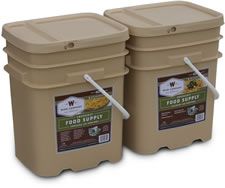Exploring Food Storage Options
Every good prepper knows the importance of an organized and well-stocked pantry. If you've not already embarked upon a food storage program, it is high time to get started. The ultimate goal should be at least a full year of food stored, which admittedly is one heck of a tall order. What I suggest is breaking that goal down into manageable pieces. Start with setting aside enough food for a week, then two weeks. From there, go for a month, then three months. Keep at it and you'll eventually get to the year of food. It takes time, energy, and of course, expense to put together a comprehensive food storage plan.
As you go through the process, you have a few different options as to the types of food to store. The basic categories are groceries, bulk items, and freeze dried/dehydrated products items. Let's look at those one at a time.
Exploring Food Storage Options
Groceries are those packaged foods you can pick up in any store, such as canned vegetables and fruits, dry pasta, and jarred sauces. This is where most preppers get started. It is very easy to toss a couple extra cans of soup into your cart when you're shopping and those couple cans every trip will add up quickly. There is also the benefit of putting aside foods you know your family likes and will eat without complaint. This plays into the prepper axiom of "Eat what you store and store what you eat." Proper rotation is a key element of a food storage plan and by storing those things you already use regularly, rotation is simple.
Canned Goods for Food Storage
The downside of relying upon groceries is many products have a limited shelf life. While the food doesn't just immediately go bad the day after the expiration date, it won't take long before you notice a change in the taste and texture of the food. Also, the further past the expiration date, the less nutrients the food may still contain. Cans and jars are heavy, bulky, and can be difficult to relocate when they are in case lots. Cans may rust in damp conditions, especially if they are just left to sit for months and months on end.
I would also include home canned foods in this category as the same caveats apply. Naturally, just about anything you can at home will be much healthier and tasty than what you'd buy in the store. That, coupled with the self-reliance aspect of food preservation is why I suggest all preppers invest in canning equipment and learn how to use it.
I suggest to preppers that common grocery items should make up about a quarter of their food storage plan. In other words, store enough of these items to last three months or so.
Bulk Storage
The next category is the bulk items. These include sacks of rice, wheat, and other grains as well as many of the common baking staples like sugar. These are great to have, provided you know how to prepare them for consumption. Considering that fancy electronic bread maker won't likely be working when the grid goes down, you'd better learn how to make bread from scratch, using a dutch oven rather than your electric stove. Having the ability to grind wheat berries into flour is a wonderful skill to have, but you need to know what to do with it.
I know several survivalists whose food storage plan revolves around these bulk items. I can't pooh pooh the idea entirely but I think eating little more than bread and such will get old rather quickly. Most of these bulk items are just ingredients to make food, rather than food in and of itself. Plus, storing these items can be problematic. Without taking rather substantial precautionary measures, grain storage is a prime target for vermin like mice.
What I suggest is to store enough bulk items like flour and wheat to supplement your meals for a year. How often could you realistically make bread, for example? Let's say three loaves a week. Obviously, the amount of each ingredient will vary depending on the recipe but we can safely average four cups of flour per loaf. That comes to roughly one pound of flour per loaf, so four pounds of flour per week. Multiply it out and you get 208 pounds of flour for a year. If you buy it in five pound sacks, that's 42 bags of flour. And that's just the flour, of course. You'll also need yeast, salt, sugar, and other ingredients. That's a whole lot of stuff, just to make bread every couple days.
Freeze Dried / Dehydrated Foods
 The final category is freeze dried and/or dehydrated foods. You can find small packages of these in any camping supply aisle and bulk packages are available online. These are excellent for long-term storage. Kept cool and dry, they will typically last a couple decades or more without any degrading at all. They are easily prepared with just hot water, though in a pinch the water doesn't need to even be warm. Freeze dried foods are light and easy to store.
The final category is freeze dried and/or dehydrated foods. You can find small packages of these in any camping supply aisle and bulk packages are available online. These are excellent for long-term storage. Kept cool and dry, they will typically last a couple decades or more without any degrading at all. They are easily prepared with just hot water, though in a pinch the water doesn't need to even be warm. Freeze dried foods are light and easy to store.
These long-term storage foods retain their nutrients and taste, both of which are important. Preparation is just a matter of minutes from opening the package to digging in your fork. The downside is cost as these specially prepared foods can be on the pricey side. But, part of that comes from buying in bulk. For example, you can buy a couple buckets that contain a total of 240 servings and it will cost you around $435.00. That's a lot of cash to pay up front. But, that breaks down to less than $2.00 per serving. If you have a family of four, when was the last time you spent less than $8.00 for a meal for the family?
I would suggest you first invest in a sample pack of these products to ensure the taste and quality meet your expectations. The vast majority of people will truly enjoy these meals but you don't want to have your first test of them being done in a true emergency.
My recommendation is to use these freeze dried foods for the bulk of your long-term storage plan. Use your common grocery items to supplement your long-term products and you'll do well in just about any disaster situation, whether it is a power outage that lasts a week or a total societal collapse.
Longtime survivalists will probably notice I didn't mention anything about the much vaunted MREs (Meals Ready to Eat). There are several reasons why I don't recommend them for food storage plans. For starters, they are very expensive. Your dollar will go much further buying groceries and freeze dried foods. They are heavy and bulky as well. Really, about the only positive is MREs are fully cooked meals that just need to be heated. You don't need to add water to rehydrate them, just heat and eat. But for my money, the list of cons far outweighs this one pro.
Your best bet with food storage is to not put all your eggs in one basket, so to speak. Diversifying your food storage allows for variety, which helps prevent appetite fatigue. Start with common groceries and add in freeze dried foods, then sprinkle in some bulk foods. Take advantage of sales when you can to stretch your dollar. Store them in cool, dry, dark places like pantries and they'll last until you need them.
